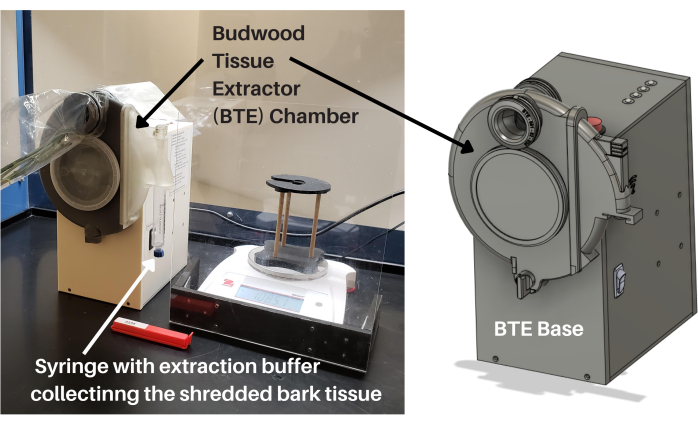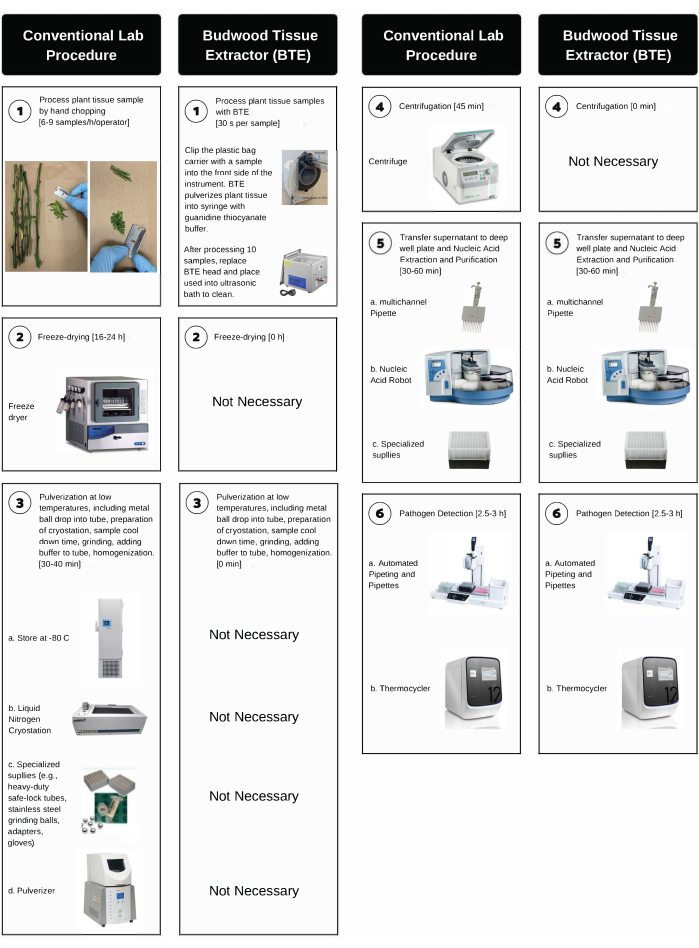機器エンジニアリングによる下流の病原体検出のための柑橘類の芽処理の自動化
Summary
師部が豊富な樹皮の柑橘類のつぼみ組織を迅速に処理する機器を設計、製造、検証しました。現在の方法と比較して、バッドウッド組織抽出器(BTE)はサンプルスループットを向上させ、必要な人件費と設備コストを削減しました。
Abstract
ウイルス、ウイロイド、バクテリアなどの柑橘類の移植片伝染性の師部制限病原体は、世界中で壊滅的な流行と深刻な経済的損失の原因となっています。たとえば、柑橘類のトリステザウイルスは世界中で1億本以上の柑橘類の木を殺しましたが、「Candidatus Liberibacter asiaticus」はフロリダに90億ドルの費用をかけました。病原体でテストされた柑橘類の芽を樹木の繁殖に使用することは、そのような病原体の管理にとって重要です。カリフォルニア大学リバーサイド校の柑橘類クローン保護プログラム(CCPP)は、ポリメラーゼ連鎖反応(PCR)アッセイを使用して、カリフォルニアの柑橘類を保護し、全米クリーンプラントネットワークにクリーンな繁殖ユニットを提供するために、毎年柑橘類の芽木源の木から数千のサンプルをテストしています。柑橘類ウイルスおよびウイロイドのハイスループット分子検出における深刻なボトルネックは、植物組織処理ステップです。
適切な組織調製は、高品質の核酸の抽出とPCRアッセイにおけるダウンストリーム使用に不可欠です。核酸の分解を避けるために、低温での植物組織の粉砕、計量、凍結乾燥、粉砕、および遠心分離は、時間と労力を要し、高価で特殊な実験装置を必要とします。この論文では、柑橘類の芽から師部に富む樹皮組織を迅速に処理するように設計された、芽木組織抽出器(BTE)と呼ばれる特殊な機器の検証を紹介します。BTEは、現在の方法と比較してサンプルスループットを100%向上させます。さらに、それは人件費と設備のコストを削減します。この研究では、BTEサンプルのDNA収量(80.25 ng / μL)は、CCPPのハンドチョッピングプロトコル(77.84 ng / μL)に匹敵しました。この機器と迅速な植物組織処理プロトコルは、カリフォルニアのいくつかの柑橘類診断研究所とプログラムに利益をもたらし、世界中の他の木本多年生作物の組織処理のモデルシステムになります。
Introduction
ウイロイド、ウイルス、バクテリアなどの柑橘類の移植片伝染性師部制限病原体は、世界のすべての柑橘類生産地域で壊滅的な流行と深刻な経済的損失を引き起こしています。柑橘類のウイロイドは、三葉、三葉の雑種、みかん、クレメンタイン、みかんなどの経済的に重要な柑橘類の種類で引き起こす外皮質と悪液質の病気のために、生産要因を制限しています1,2,3。カリフォルニアでは、これらのウイロイドに敏感な柑橘類の種類は、皮をむきやすく、セグメント化され、種のない果物に対する消費者の好みの変化傾向に続いて、「イージーピーラー」の成長と収益性の高い市場の基盤となっています4,5,6。したがって、柑橘類のウイロイドは、カリフォルニア州食品農業省(CDFA)の「柑橘類の苗床害虫清浄度プログラム-上院法案140」の下で規制されており、CDFAの植物害虫診断部門の研究所は、毎年何千もの柑橘類のウイロイド検査を実施しています7,8,9,10 .カンキツトリステザウイルス(CTV)は、1930年代の世界的な流行が始まって以来、1億本以上の柑橘類の木の死の原因となっています3,9,10,11。カリフォルニアでは、ウイルスの茎の孔食と三葉の破壊抵抗分離株が、36億ドルのカリフォルニアの柑橘類産業に深刻な脅威をもたらします12,13,14。その結果、CDFAはCTVを規制されたクラスAの植物害虫として分類し、中央カリフォルニアトリステザ根絶局(CCTEA)の研究所は毎年広範な現地調査と数千のウイルス検査を実施しています15,16。細菌「Candidatus Liberibacter asiaticus」(CLas)と黄龍峰(HLB)病は、柑橘類の作付面積が40%減少し、柑橘類の操業が57%減少し、約8,000人の雇用が失われた結果、フロリダに90億ドル近くの経済的損害をもたらしたと推定されています17,18。カリフォルニア州では、HLBによる柑橘類の作付面積の仮想的な20%の減少は、8,200人以上の失業と州の国内総生産の50億ドル以上の減少をもたらすと予測されました。したがって、柑橘類の害虫および疾病予防プログラムは、カリフォルニア14,17,19,20からのCLaをテスト、検出、および根絶するための調査に年間4,000万ドル以上を費やしています。
柑橘類のウイロイド、ウイルス、バクテリアの管理の重要な要素は、樹木生産のための病原体テストされた繁殖材料(すなわち、芽木)の使用です。病原体検査済みの柑橘類の芽は、高度な病原体除去および検出技術を採用した包括的な検疫プログラム内で生産および維持されています10,21。カリフォルニア大学リバーサイド校の柑橘類クローン保護プログラム(CCPP)は、カリフォルニアの柑橘類を保護し、柑橘類の全国クリーンプラントネットワークの機能をサポートするために、州と米国に新たに輸入された柑橘類の品種と柑橘類の芽木源の木から毎年何千もの芽材サンプルをテストしています10,17,22.大量の柑橘類検査を処理するために、ハイスループット、信頼性が高く、費用対効果の高い病原体検出アッセイは、CCPP 7,10,22などのプログラムの成功のための基本的な要素です。
ポリメラーゼ連鎖反応(PCR)などの分子ベースの病原体検出アッセイにより、植物診断ラボのスループットが大幅に向上しましたが、私たちの経験では、ハイスループットプロトコルの実装における最も重要なボトルネックの1つは、植物組織サンプル処理ステップです。これは、葉の葉柄や芽木の樹皮などの師部に富む組織の処理に現在利用可能なプロトコルが労働集約的で時間がかかり、高価で特殊な実験装置を必要とするため、特に柑橘類に当てはまります。これらのプロトコルでは、核酸の分解を避けるために、低温での手切り、計量、凍結乾燥、粉砕、および遠心分離が必要です8,23,24。たとえば、CCPP診断ラボでは、サンプル処理には、(i)手切り(6〜9サンプル/時間/オペレーター)、(ii)凍結乾燥(16〜24時間)、(iii)粉砕(30〜60秒)、および(iv)遠心分離(1〜2時間)が含まれます。このプロセスには、特殊な消耗品(頑丈な安全ロックチューブ、ステンレス鋼の粉砕ボール、アダプター、ブレード、手袋など)と複数の高価なラボ機器(超低冷凍庫、凍結乾燥機、組織粉砕機、液体窒素凍結、冷蔵遠心分離機など)も必要です。
他の業界と同様に、機器のエンジニアリングとプロセスの自動化は、コストを削減し、スループットを向上させ、高品質で均一な製品とサービスを提供するための鍵です。柑橘類業界では、操作に最小限のスキルしか必要としない低コストの組織処理機器が必要であり、診断ラボやフィールド操作に簡単に転送できるため、下流の病原体を迅速に検出するための高いサンプル処理能力が可能になります。テクノロジーエボリュービングソリューション(TES)とCCPPは、師部に富む柑橘類の組織(すなわち、芽)を迅速に処理するための低コスト(すなわち、特殊な実験装置の必要性を排除した)機器を開発(すなわち、設計および製造)し、検証しました(すなわち、柑橘類のサンプルでテストし、標準的な実験室手順と比較して)、芽木組織抽出器(BTE)と名付けました。 図1に示すように、BTEには、電源と制御用のベースコンポーネントに加えて、柑橘類の芽を処理するための取り外し可能なチャンバーが含まれています。BTEチャンバーは、師部に富む樹皮組織を柑橘類の芽から取り除くために特別に設計された砥石で構成されています。細断された樹皮組織は、スライドポートから抽出バッファーを含むシリンジに迅速に排出され、ろ過され、追加の取り扱いや準備なしで核酸の抽出と精製の準備が整います(図1)。BTEシステムには、ペーパーレスのサンプル追跡アプリケーションと統合された計量アプリケーションも含まれており、サンプル処理情報をオンラインデータベースにリアルタイムで記録します。
BTEシステムは、CCPPのラボ診断能力を100%以上向上させ、PCRアッセイを使用した高品質の核酸の精製と柑橘類の移植片伝染性病原体の下流検出に適した柑橘類組織抽出物を一貫して製造してきました。具体的には、BTEは組織処理の時間をサンプルあたり24時間以上から~3分に短縮し、60,000ドルを超えるラボ機器を置き換え(図2、ステップ2-4)、より大きなサンプルサイズの処理を可能にしました。
この論文では、CCPP Rubidoux Quarantine FacilityとLindcove Foundation Facilityからのすべての適切なポジティブコントロールとネガティブコントロールを含む、ソースツリーからの柑橘類の芽木サンプルを使用したBTEハイスループット柑橘類樹皮組織処理、核酸抽出、および病原体検出検証データを紹介します。また、現在のラボ手順と比較したスループットと処理時間の変化も示します(図2)。さらに、この作業は、柑橘類病原体検査ラボに詳細な段階的なプロトコルを提供し、BTEが病原体クリーンな苗床、調査、および根絶プログラムの機能をどのようにサポートできるかを示しています。

図1:バッドウッド組織抽出器。 BTEには、電源と制御用のベースコンポーネントに加えて、柑橘類の芽を処理するための取り外し可能なチャンバーが含まれています。BTEチャンバーは、師部に富む樹皮組織を柑橘類の芽から取り除くために特別に設計された砥石で構成されています。細断された樹皮組織は、スライドポートからシリンジに迅速に排出され、ろ過され、追加の取り扱いや準備なしで核酸の抽出と精製の準備が整います。略語:BTE =バッドウッド組織抽出器。 この図の拡大版を表示するには、ここをクリックしてください。

図2:従来のハンドチョッピングラボ手順とBTE処理の段階的な比較。 BTE処理には、ハイスループットの柑橘類樹皮組織処理、核酸抽出、および病原体検出が含まれます。各ステップの時間は括弧内に示されています。 この図の拡大版を表示するには、ここをクリックしてください。
Protocol
Representative Results
Discussion
HLB柑橘類病の出現により、損失を減らすために、柑橘類産業、規制当局、および診断研究所は、病気管理の実践と組み合わせて、個々の樹木の検査のために、低スループットの手動サンプル処理およびqPCR34 などの病原体検出アッセイと組み合わせたハイスループット核酸抽出法に依存するように促されています35.カリフォルニア州のHLB陽性率は、2012年の0….
Disclosures
The authors have nothing to disclose.
Acknowledgements
著者らは、カフイラの人々を実験作業が完了した土地の伝統的な管理者として認めています。カリフォルニア大学リバーサイド校のノーマン・エルストランド教授には、UCRカリフォルニア農業食品企業(CAFÉ)イニシアチブの下でこのプロジェクトの研究活動を行うためのラボスペースを提供していただき、感謝しています。この研究は、CDFA-特殊作物ブロック助成プログラム(助成金番号18-0001-055-SC)の支援を受けました。追加のサポートはCRBプロジェクト6100によっても提供されました。USDA国立食糧農業研究所、ハッチプロジェクト1020106;National Clean Plant Network-USDA Animal and Plant Health Inspection Service (AP17PPQS&T00C118, AP18PPQS&T00C107, AP19PPQS&T00C148, & AP20PPQS&T00C049) がゲオルギオス・ヴィダラキスに授与されました。
Materials
| 0.08" Hex Trimmer line | PowerCare | FPRO07065 | Needed to replace blades. |
| 1 Hp, 8 gal air compressor | California Air Tools | 8010 | Quickly dry chambers after rinsed |
| 1.5 mL microcentrifuge tube | Globe Scientific | 111558B | Store sample in after swishing with syinges |
| 10 mL Syringe Set | Technology Evolving Solutions | TE006-F1-10A-G1000-E1 | Syringe material is cut into. 1 L bottle with guanidine thiocyanate buffer. WARNING – contains guanidine thiocyanate, hazardous waste service required – do not mix with bleach |
| 12" Ruler | Westcott | 16012 | To measure trimmer line before cutting |
| 12% Sodium Hypochlorite | Hasa | 1041 | Disinfects chambers after processing |
| -20 C Freezer | Insignia | NS-CZ70WH0 | Store sample after processing |
| 4" x 12" plastic bags | Plymor | FP20-4×12-10 | Bags to hold branches during shipping. O-rings attach bag to BTE chamber to seal |
| 6" Cotton Swab | Puritan | 806-PCL | Swab to remove clogs |
| 7 Gallon Storage Tote | HDX | 206152 | Holds sodium hypochlorite solution to disinfect chambers and water to rinse chambers |
| Air blow gun | JASTIND | JTABG103A | Directs air into the chambers at high pressure |
| Black Sharpie | Sharpie | S-19421 | Mark 1.5 mL tubes so you can identify sample later |
| Bottle Top Dispensor | Brand | Z627569 | Adjustable bottle top dispensor to dispense guandine into syringe |
| BTE Chamber | Technology Evolving Solutions | TE002BB-A05-E1 | Used to process budwood. Includes O-rings, BTE Slide, slide plunger, drain valve, lid, blade set, and blade set removal tool |
| Dish Soap | Dawn | 57445CT | Surfectant to improve sodium hypochlorite penetration into chamber |
| Fume hood with hepa filter | Air Science | P5-36XT-A | Fume hood with hepa filter (ASTS-030) to limit possible contamination and protect against chemical spills |
| Insulated foam shipping container | PolarTech | 261/J50C | Insulated shipping container to ship samples on ice after they are collected |
| Lab coat | Red Kap | KP14WH LN 46 | Lab coat to limit possible contamination and protect against chemical spills |
| Laptop | Microsoft | Surface | Wifi capable laptop to run TES GUI. Needed for initial setup and provides more indepth information about the tissue processing base |
| NFC Capable Phone | Samsung | Galaxy S9 | Phone to download and use TES phone app |
| NFC clip tag | Technology Evolving Solutions | TE005-Clip-E1 | Sample tag that can be linked with trees. Made to function with TES phone app |
| NFC Collar Tag | Technology Evolving Solutions | TE005-Collar-E1 | Tag that is attached to a tree. Made to function with TES phone app |
| Nitrile Gloves | Usa Scientific | 3915-4400 | Gloves to limit possible contamination and protect against chemical spills |
| Noise-Reducing Earmuff | 3M | 90565-4DC-PS | Protect ears while operating air compressor and tissue processing base |
| Polyurethane Recoil Air Hose | FYPower | 510019 | Attaches air gun to compressor |
| Saftey glasses | Solidwork | SW8329-US | Protect eyes for chemical and physical hazards |
| Spray bottle | JohnBee | B08QM81BJV | Spray bleach to deconatinate surfaces |
| Tissue Extractor Base | Technology Evolving Solutions | TE001-A-E1 | System to process plant tissue. Needs BTE or LTE chambers to function. Includes power cable, blade adapter, and 8/32" allen wrench |
| Tissue Processing Base Weight Scale | Technology Evolving Solutions | TE003-A05-200g-01-E1 | 200 g, 0.01 resolution weight scale that connects to tissue processing base to enforce weight ranges and/or link weights with sample. Includes scale, power cable, connection cable, 5ml syringe holder, tower air shield |
| Vermiculite | EasyGoProducts | B07WQDZGRP | Needed to transport hazardous waste (guanidine thiocyanate) using a hazardous waste disposal service |
| Wire Cutter | Boenfu | BOWC-06002-US | Wire cutters to cut trimmer line |
References
- Vernière, C., et al. Interactions between citrus viroids affect symptom expression and field performance of clementine trees grafted on trifoliate orange. Phytopathology. 96 (4), 356-368 (2006).
- Vernière, C., et al. Citrus viroids: Symptom expression and effect on vegetative growth and yield of clementine trees grafted on trifoliate orange. Plant Disease. 88 (11), 1189-1197 (2004).
- Zhou, C., Talon, M., Caruso, M., Gmitter, F. G., et al. Chapter 19 – Citrus viruses and viroids. The Genus Citrus. , 391-410 (2020).
- Trends and issues facing the U.S. citrus industry. Choices Magazine Online Available from: https://www.choicesmagazine.org/choices-magazine/theme-articles/trends-and-challenges-in-fruit-and-tree-nut-sectors/trends-and-issues-facing-the-us-citrus-industry (2021)
- Fruit and Tree Nuts Outlook. United States Department of Agriculture-Economic Research Service Available from: https://www.ers.usda.gov/webdocs/outlooks/98171/fts-370.pdf?v=5697 (2020)
- Forsyth, J., Fruits Damiani, J. C. i. t. r. u. s. Citrus Fruits. Types on the market. Encyclopedia of Food Sciences and Nutrition. , 1329-1335 (2003).
- Bostock, R. M., Thomas, C. S., Hoenisch, R. W., Golino, D. A., Vidalakis, G. Plant health: How diagnostic networks and interagency partnerships protect plant systems from pests and pathogens. California Agriculture. 68 (4), 117-124 (2014).
- Osman, F., Dang, T., Bodaghi, S., Vidalakis, G. One-step multiplex RT-qPCR detects three citrus viroids from different genera in a wide range of hosts. Journal of Virological Methods. 245, 40-52 (2017).
- Wang, J., et al. Past and future of a century old Citrus tristeza virus collection: A California citrus germplasm tale. Frontiers in Microbiology. 4, 366 (2013).
- Gergerich, R. C., et al. Safeguarding fruit crops in the age of agricultural globalization. Plant Disease. 99 (2), 176-187 (2015).
- Moreno, P., Ambrós, S., Albiach-Martí, M. R., Guerri, J., Peña, L. Citrus tristeza virus: A pathogen that changed the course of the citrus industry. Molecular Plant Pathology. 9 (2), 251-268 (2008).
- Yokomi, R. K., et al. Identification and characterization of Citrus tristeza virus isolates breaking resistance in trifoliate orange in California. Phytopathology. 107 (7), 901-908 (2017).
- Selvaraj, V., Maheshwari, Y., Hajeri, S., Yokomi, R. A rapid detection tool for VT isolates of Citrus tristeza virus by immunocapture-reverse transcriptase loop-mediated isothermal amplification assay. PLoS One. 14 (9), 0222170 (2019).
- Babcock, B. A. Economic impact of California’s citrus industry in 2020. Journal of Citrus Pathology. 9, (2022).
- Gottwald, T. R., Polek, M., Riley, K. History, present incidence, and spatial distribution of Citrus tristeza virus in the California central valley. International Organization of Citrus Virologists Conference Proceedings (1957-2010). 15, (2002).
- Yokomi, R., et al. Molecular and biological characterization of a novel mild strain of citrus tristeza virus in California. Archives of Virology. 163 (7), 1795-1804 (2018).
- Fuchs, M., et al. Economic studies reinforce efforts to safeguard specialty crops in the United States. Plant Disease. 105 (1), 14-26 (2021).
- The real cost of HLB in Florida. Citrus Industry Magazine Available from: https://citrusindustry.net/2019/07/30/the-real-cost-of-hib-in-florida/ (2019)
- McRoberts, N., et al. Using models to provide rapid programme support for California’s efforts to suppress Huanglongbing disease of citrus. Philosophical Transactions of the Royal Society B: Biological Sciences. 374 (1776), 20180281 (2019).
- Albrecht, C., et al. Action plan for Asian citrus psyllid and huanglongbing (citrus greening) in California. Journal of Citrus Pathology. 7 (1), (2020).
- Navarro, L., et al. The Citrus Variety Improvement Program in Spain in the period 1975-2001. International Organization of Citrus Virologists Conference Proceedings (1957-2010). 15 (15), (2002).
- Vidalakis, G., Gumpf, D. J., Polek, M. L., Bash, J. A., Ferguson, L., Grafton-Cardwell, E. E. The California Citrus Clonal Protection Program. Citrus Production Manual. , 117-130 (2014).
- Dang, T., Rao, A. L. N., Lavagi-Craddock, I., Vidalakis, G., et al. High-throughput RNA extraction from citrus tissues for the detection of viroids. In Viroids: Methods and Protocols. 2316, (2022).
- Osman, F., Vidalakis, G., Rao, A. L. N., Lavagi-Craddock, I., Vidalakis, G. Real-time detection of viroids using singleplex and multiplex quantitative polymerase chain reaction. Viroids: Methods and Protocols. 2316, (2022).
- Li, R., et al. A reliable and inexpensive method of nucleic acid extraction for the PCR-based detection of diverse plant pathogens. Journal of Virological Methods. 154 (1-2), 48-55 (2008).
- Saponari, M., Manjunath, K., Yokomi, R. K. Quantitative detection of Citrus tristeza virus in citrus and aphids by real-time reverse transcription-PCR (TaqMan). Journal of Virological Methods. 147 (1), 43-53 (2008).
- Damaj, M. B., et al. Reproducible RNA preparation from sugarcane and citrus for functional genomic applications. International Journal of Plant Genomics. 2009, 765367 (2009).
- Dang, T., et al. First report of citrus leaf blotch virus infecting Bearss lime tree in California. Plant Disease. 104 (11), 3088 (2020).
- Manchester, K. L. Use of UV methods for measurement of protein and nucleic acid concentrations. BioTechniques. 20 (6), 968-970 (1996).
- Teare, J. M., et al. Measurement of nucleic acid concentrations using the DyNA QuantTM and the GeneQuantTM. BioTechniques. 22 (6), 1170-1174 (1997).
- Imbeaud, S. Towards standardization of RNA quality assessment using user-independent classifiers of microcapillary electrophoresis traces. Nucleic Acids Research. 33 (6), 56-56 (2005).
- Menzel, W., Jelkmann, W., Maiss, E. Detection of four apple viruses by multiplex RT-PCR assays with coamplification of plant mRNA as internal control. Journal of Virological Methods. 99 (1-2), 81-92 (2002).
- Vidalakis, G., Rao, A. L. N., Lavagi-Craddock, I., Vidalakis, G., et al. SYBR Green RT-qPCR for the universal detection of citrus viroids. Viroids: Methods and Protocols. , 211-217 (2022).
- Arredondo Valdés, R., et al. A review of techniques for detecting Huanglongbing (greening) in citrus. Canadian Journal of Microbiology. 62 (10), 803-811 (2016).
- Li, S., Wu, F., Duan, Y., Singerman, A., Guan, Z. Citrus greening: Management strategies and their economic impact. HortScience. 55 (5), 604-612 (2020).
- . CDFA California Citrus Pest and Disease Prevention Program Operations Subcomittee Meeting. Meeting Minutes Available from: https://www.cdfa.ca.gov/citrus/docs/minutes/2019/OpsSubcoMinutes-11062019.pdf (2019)

